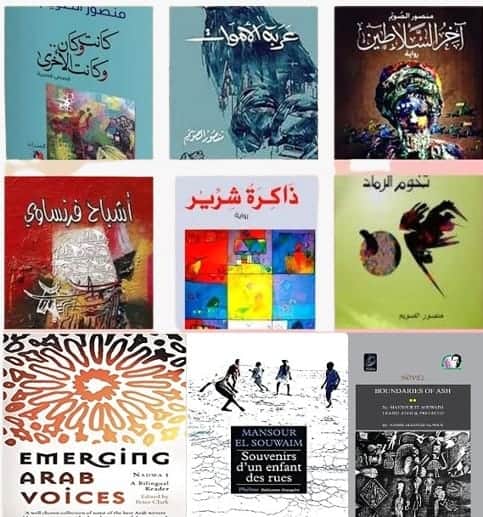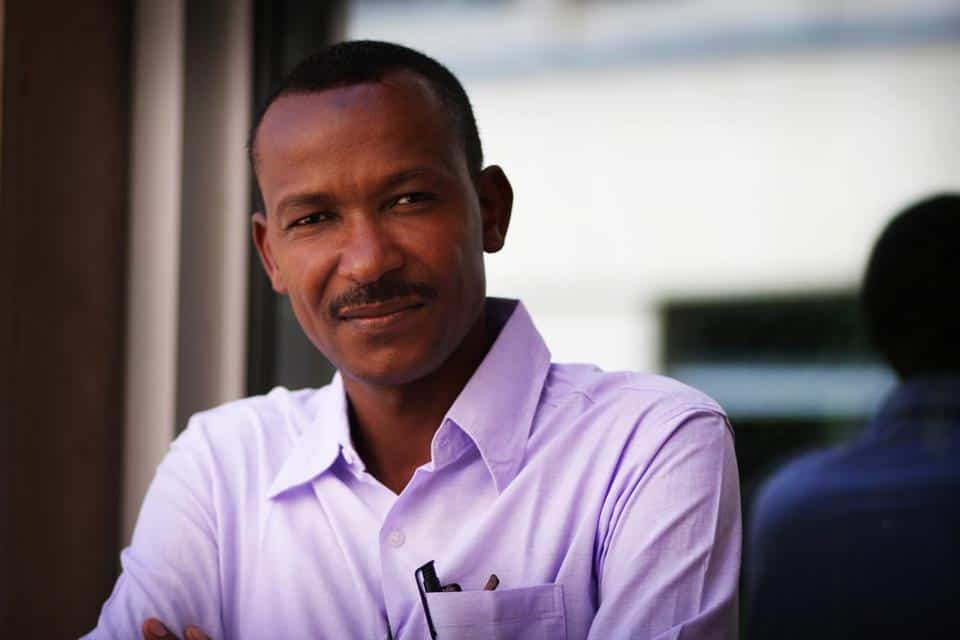Mansour El Souwaim is an acclaimed Sudanese novelist with an international reputation as a short story writer and journalist. During his literary tenure of more than two decades (since 2001), he has published several compelling fictional narrative works. His fictional production focuses on the novelistic genre. Critically, his works are welcomed at national and international levels—some of his novels translated into English and French. Moreover, he was awarded many prestigious literary prizes and he has participated in international conferences in the Arab World and Europe. He’s written six novels and one short story collection in addition to the many feature articles in the cultural public sphere. In this brief exploration, I trace the human aspect of his novels in connection with the narrative structure he has built.

Boundaries of Ash
El Souwaim, who was born in the city of Nyala in the Darfur region of Western Sudan debuted his short novel (novella) Tukhum Eramad, Boundaries of Ash in 2001. The novel reflected the region’s intense fermented conflict of tribal and political polarization which later resulted in a notorious human genocide that tugged the conscience of the world. This novel is considered by many as an early warning of the imminent disaster that would later ravage the Darfur region of Western Sudan. El Souwaim managed to artistically anticipate reality as fully interpreted novel elements. The story events took place in the Darfur region where armed robbery, conspiracy and official corruption led by high-ranking military and official men resulted in setting a village on fire and killing civilians.
The main character, the narrator, symbolizes the corrupted power manipulated by those in military positions. Besides other voices, the novel within a narrower space of movement expresses the writer’s growing technique in the writing of novels. Eventually, Boundaries of Ash managed to present what was lacking in that vanished time. It compensated for this flaw by relying on the interplay of language connotations within a poetic context, although depending on the narration risks the destruction of the entire work.
The Memory of Bad Boy
His next novel, The Memory of Bad Boy, or Zakirat Sherair, was translated into French by professor France Meyer Souvenirs d’un enfant des rues. This time, El Souwaim’s narrative tools were sharpened, vision widened and imagination enriched by the acquired experience and intensive writing work as a journalist and short story publisher. Eventually, the novel was highly praised and awarded the Altayeb Saleh Prize in 2005 after the name of the Sudanese iconic novelist of Season Migration to the North. The novel addresses the marginalized groups of street boys in Sudan’s main cities who are rarely articulated artistically. It presented the world of the voiceless human and disengaged groups labeled by social stigma as homeless boys. He used poetic language and made the vital characters cope with this challenging world to reflect the narrative structure of narrative flow. To do this, he encapsulates social research criteria and journalistic investigations to create narrative fabrics. However, this does not provide a realistic writing style that opts to transfer the ground facts into a narrative discourse. There’s a span covered by imaginative tools of the novelist who had avoided the directness of reporting.
The novel narratively succeeded in revealing the social interaction of the homeless where they live their day-to-day life away from formal social institutions and they neither belong to biological nor lineage affiliations. The hero Adam Kussahi a disabled young boy tragically missed his mother Mariyam, and then was thrown into the social web of the homeless street to survive by begging. Besides his morbid life developments, he was manipulated by a woman as a sexual tool in a profane environment mixed with religion and witchcraft.
The Ghosts of Fransawi
A third work, The Ghosts of Fransawi, or Ashbah Fransawi, is dramatically and symbolically enriched by its poetic language focused on the life of Awad Fransawi, who embodies life’s fated events. In the novel, El Souwaim attempts to test a new narrative technique not used in his previous works. The plot of the novel is in the voice of the narrator and it describes Fransawi’s stages of life divided by places in Darfur and Khartoum, the capital of Sudan.
In a sequential narrative series, the novel slowly moves into the details that constitute the structure of the narrative formation of the Franswai story. By using the technique of focalization, the novel reconnects between place and events. In some parts, the place overtook the events, interacting with its elements to include typographical description, daily life activities, environmental factors and the human impact.
The Last Sultan
From human inertia to the historical context, El Souwaim moved into another biography and historical narrative writing style. He wrote The Last Sultan, or Akir el-Salateen, in 2015. The novel is a biographical story of Ali Dinar who ruled as Sultan during a brief era of Sudan’s relative independence from Anglo-Egyptian bilateral control. Through the use of compelling and well-developed characters, El Souwaim brings alive the flamboyant history of this now-defunct African Sultanate, beginning with the British overthrow of the Mahdi’s State. This collapse of the state marked a new era in Sudanese history and a period of peace and relative independence for Darfur, located along Sudan’s western periphery.
The Last Sultan sums up chronological events without judging the results. Simply put, it goes beyond just telling the history of the rise and fall of the character Sultan Ali Dinar. It is also a contemplative exploration of Darfur’s role in history. The irony is that this region, which began by defending itself against an external threat, paradoxically became a region whose people risked extinction by a threat from their fellow Sudanese. The novel not only explored the military of the Sultanate and political history of the Sultan Ali Dinnar, it rather detectives the psychological and personal perspectives of the Sultan as a human being.
The Chariot of the Dead
One of his tour de force’s is his The Chariot of the Dead, or Arabat al-Amwat, a novel published in 2017 in which El Souwaim has cemented his visionary imaginative experience of writing. The novel tells the story of expat workers facing difficulties in a Gulf petrol state. He understandably reveals the human weaknesses culminating in fear, disappointment and despair. The narrator dominates the entire work by using an idiosyncratic narrative that presents a mosaic of controversial interactive events among the marginalized characters. Time is a crucial challenge to the artistry of the novel since the plot is confined to the time being represented. Two characters, the narrator and the crow, diachronically dominate the events, one strives to bring our attention to the aesthetic elements and the other controls the body of the text. Sometimes these voices are jumbled in the sequences of the events, even to the extent of detaching from the main narrative. The fascinated character of the crow revealed a highly interesting narration to the degree that the novel metaphorizes the unity of the universe.
Blue Algae
Lastly, his novel Blue Algae, or Tuhlub Azraq, published in 2023, was awarded the Tayeb Salih International Award for Creative Writing. The book divulged the political corruption and despotism of the ruling elite in Sudan. The novel has well captured the rooted political conflict and how absolute power, exercised by a clique, used religion and ethnic polarization as a pretext to destabilize social cohesion due to disillusion.
El Souwaim’s humanistic theme is considered the main factor shaping his works in his narrative project. Neither ideology nor political beliefs guided his narrative depiction of the weakness of human obsessions. Like any other writer, he’s in a position from which his world vision, or Weltanschauung, is defined, but by no means reduces the limits of the worlds the writer created, isolated from the facts that are embedded in sociocultural and political discourse. Along six narrative works, El Souwaim precisely depicted his characters’ fictional motivations and envisioned their destiny, interwoven with deeply psychological interactions. It’s an ontological inquiry into the debacle of human suffering.
Critical Overview
Critically, and to some extent in terms of cultural analysis, his mission as a novelist to manipulate the combination of interdisciplinary scope of anthropological and folkloric culture has contributed to making his characters clearly express their desires, dreams and possibly ambitions in uneven waves of life. These scattered human dimensions couldn’t actively play a crucial role in the narrative without a natural creative vision that rationally separates the point of view in terms of novel writing technique and the writer’s position. This can be traced to mostly great writers whose works have been edified according to the fulfillment of their goals. The question of human existence has always been a forceful mainstreaming polemic one, not only restricted to philosophical accounts, but it encompasses a range of human experiences as creatures seeking the meaning of life at large.
Recently, the generation of Sudanese writers to whom El Souwaim belongs has sought to answer one of the nation’s unavoidable questions of identity which shares blame in the country’s unremitting repugnant conflicts. Novelists such as Baraka Sakin, Hamour Ziada and Abdel Hafeez Maryooud raised the issue in its humanistic perspectives in their works, and they deeply excavated their nation’s historical cultural amalgamation to narratively conceptualize the hidden factors behind the human weaknesses. The highest loss affecting the torn country, as the mentioned novelists have meticulously exposed, is the human tragedy whether it be the war, displacement, gross human rights violations or all other unspoken crimes representing the ugliest face of war.
The war, as a human phenomenon, has long been a prominent theme in narrative prose, receiving significant attention for its critical perspectives and cultural literary discourse. Nonetheless, war in mankind’s history is vigorously rooted deeper in modern literary human discursive traditions. The great Russian novelist Tolstoy remarkably wrote his epic novel War and Peace where the human sometimes intermingles with very human nuisances and it is not only an account of military events from a historical perspective.
Eventually, the paradox of war as a human activity launched under different excuses represents human fault and failure in the absence of mind and conscience altogether. It is mostly modeled by novel formation, but its focus on limited expressions of language and stylistic techniques lies in the latent Western complex way of developing a writing process. Any critical approach to trace what a fictional work has tackled surely depends on human concerns from which the work shaped its structure. In response to his novelistic experience and his stature as a skilled novelist, El Souwaim provides a fictional realm filled with human effects. Taken into account, he employs his vast imagination as a talented narrator, and the given facts of the human experience implicit in human-produced knowledge.
By Nassir al-Sayeid al-Nour


Sudanese critic, translator
and author.
